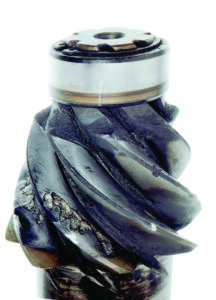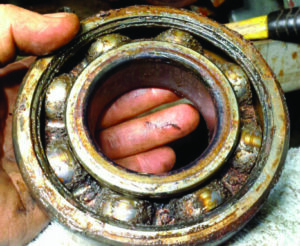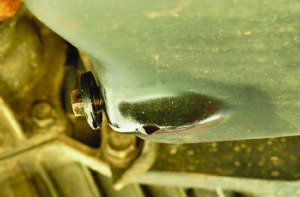Failure Diagnoses
Failure diagnoses – When failures occur in mechanical components of mobile or industrial equipment, evidence of failure is often destroyed along with the mechanical component that suffered the failure. The initial evidence of failure is so mischaracterized by the actual failure that it becomes indistinguishable from other evidence. The destruction of the initial 
 evidence of failure usually leads the investigator to charge the lubricant because of damage caused by another mechanism. Conversely, failures that were caused by the use of inadequate lubricant or ineffective lubrication are mistakenly attributed to other factors. There are many possible cause-and-effect situations where evidence about the cause of failure is lost in evidence about the effect. The absence of good evidence is what leads to costly wrong decisions about acting or not acting in a given situation of damage to mobile or industrial equipment. Most of the time, it is not even possible to determine if the damage that occurred was somehow preventable or if it was something casual and should be accepted as such.
evidence of failure usually leads the investigator to charge the lubricant because of damage caused by another mechanism. Conversely, failures that were caused by the use of inadequate lubricant or ineffective lubrication are mistakenly attributed to other factors. There are many possible cause-and-effect situations where evidence about the cause of failure is lost in evidence about the effect. The absence of good evidence is what leads to costly wrong decisions about acting or not acting in a given situation of damage to mobile or industrial equipment. Most of the time, it is not even possible to determine if the damage that occurred was somehow preventable or if it was something casual and should be accepted as such.
 Many maintenance professionals have come across recurring failure modes in machinery without having an idea of the root cause of the failure. As it is not possible to accurately locate the root cause of failures, the solution is to create complex and often innocuous and unnecessary Preventive Maintenance procedures (PMs). Implementing a set of Preventive Maintenance procedures (PMs) is a very common response when it is not possible to explain the reason for the failure of the machinery.
Many maintenance professionals have come across recurring failure modes in machinery without having an idea of the root cause of the failure. As it is not possible to accurately locate the root cause of failures, the solution is to create complex and often innocuous and unnecessary Preventive Maintenance procedures (PMs). Implementing a set of Preventive Maintenance procedures (PMs) is a very common response when it is not possible to explain the reason for the failure of the machinery.
 It is relatively common that, once innocuous and unnecessary Preventive Maintenance procedures (PMs) are introduced in the maintenance system, they become a permanent part of maintenance practices, no longer being discontinued even if their ineffectiveness becomes evident. With time, you will no longer remember why those innocuous, unnecessary, costly and laborious Preventive Maintenance (PM) procedures were instituted and the process of rationalizing maintenance practices by removing ineffective practices will always require long and fierce debates.
It is relatively common that, once innocuous and unnecessary Preventive Maintenance procedures (PMs) are introduced in the maintenance system, they become a permanent part of maintenance practices, no longer being discontinued even if their ineffectiveness becomes evident. With time, you will no longer remember why those innocuous, unnecessary, costly and laborious Preventive Maintenance (PM) procedures were instituted and the process of rationalizing maintenance practices by removing ineffective practices will always require long and fierce debates.
 Lubrication failure occurs when the lubricant fails to effectively separate metal surfaces from mechanical components in relative motion. However, there are numerous reasons why this could happen.
Lubrication failure occurs when the lubricant fails to effectively separate metal surfaces from mechanical components in relative motion. However, there are numerous reasons why this could happen.
There are totally different situations in this aspect and we can cite as an example:
- Vibration leads to loosening of the crankcase drain plug of mobile or industrial equipment, total loss of lubricating oil, and consequent catastrophic failure.
- Mobile or industrial equipment operates in an extremely dusty environment, the lubricant becomes contaminated with abrasives, and abrasive wear accelerates.
Both situations will cause lubrication failure from a maintenance and prevention perspective, but they are totally different events.
 How, then, can the quality of evidence and the skills to examine it be improved? In the vast majority of failures, catastrophic or not, in mobile or industrial equipment, evidence of damage can still be found either in the lubricating oil or in the lubrication system, even if the evidence in the mobile component has been destroyed.
How, then, can the quality of evidence and the skills to examine it be improved? In the vast majority of failures, catastrophic or not, in mobile or industrial equipment, evidence of damage can still be found either in the lubricating oil or in the lubrication system, even if the evidence in the mobile component has been destroyed.
Click the image below to read the complete article in the digital version of “LUBES EM FOCO MAGAZINE – issue 83” :






















